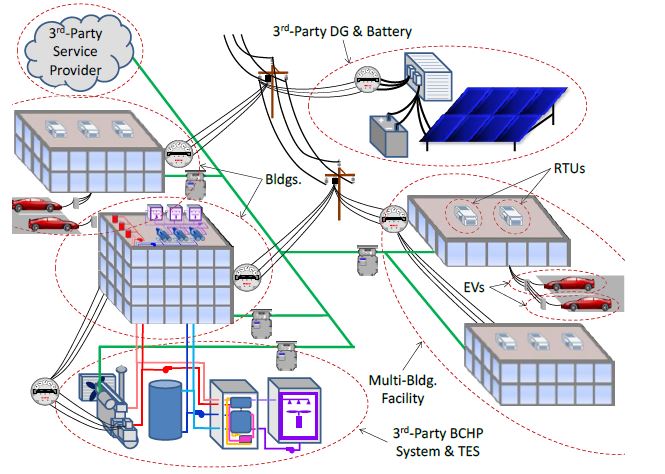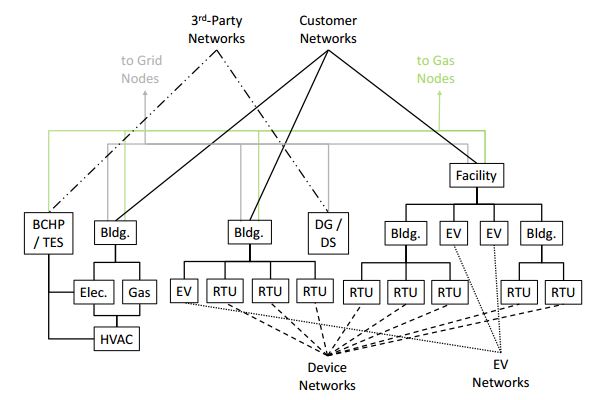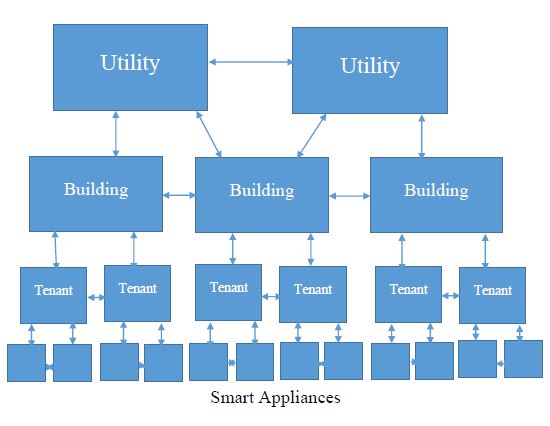Building Energy Management: Control Hierarchy
ABBREVIATIONS AND KEYWORDS
Bldgs. – Buildings
DG – Distributed Generation
EV- Electrical Vehicle
HVAC – Heating, Ventilation & Air Conditioning
RTU – Rooftop Unit
TES – Thermal Energy Storage
INTRODUCTION
Buildings currently consume approximately 70% of the nation’s total electricity. Some advances, such as improvements in building codes, have helped increase the efficiency of new buildings. Although the improvements can increase savings up to 20%, a large part of wasted energy is due to lack of control. An estimated $30 billion worth of energy are wasted due to lack of controls. The current power system in the United States is a unidirectional. The traditional power grid contains a system of generators that are connected to a transmission network, that are then joined to a substation, where the voltage is finally distributed to the consumer. The only control is on the utility side of the system.
CONTROLS FRAMEWORK
The future power system will be interconnected. A highly optimized control system will be implemented at all levels which will increase efficiency and lower energy cost. The different components can be controlled by negotiating immediate and conditional contracts with its peers, suppliers, and customers. These deals are designed to maximize revenue and minimize cost. The control system will limit demand by providing the most cost effective service, decreasing energy demand and consumption. Cost fluctuates through hierarchal levels of the system being controlled. The addition of smart meters will allow all levels of the power system to communicate with each other and will perform based on the information it receives from the network. These transactions will lead to both economic and environmental benefits. Data centers will be implemented to shift jobs to another service provider to save electricity. When the costs are too high they will shift to another center where the costs will be reduced.
Rooftop units will be installed on buildings and rather than the building paying for services from the utility company, they will both be able to supply the needs of one another. If there is a high demand for energy the market framework (control center) will ask the utility company if they are willing to pay for services and if the building can supply them. If they both agree the building will cut its load, by dimming lights or other means, and the utility company will pay in return. Similar transactions will occur through the various components throughout the network. Constraints can be set to determine the needs of energy for certain buildings within the system, for example a hospital will have higher priority for energy than an office building during a blackout.

Figure 1: Representation of Rooftop Units and Electric Vehicles Connected to the grid

Figure 2: Block Diagram of 3rd Party DG and Consumer DG
The figure below visually represents the control hierarchy of a future power grid. There are communications between utility companies, and communication between the utility companies with buildings. The buildings interact with each other as well as with the tenants inside the building. The tenants will have smart appliances installed that interact with one another. At all levels of the power system, transactions will occur with every component that is connected. These transactions will be based on whether or not a component needs energy, and if the others within the network can provide it. Once there is an agreement the “supplier” of energy will reduce its load, and the one receiving the energy will pay for the service.

Figure 3: Flowchart describing the communication between various levels of the future power grid
Within the building tenants will purchase energy from the building. The tenants will transact with each other similarly to the buildings and utility companies. The tenants will bid on energy based on their needs and what they are willing to pay. Like the constraints that prioritize which buildings get energy, physical constraints can be set, such as temperature, to keep the tenants operating at a comfortable level. At any even smaller level smart appliances need to be installed to save even more costs, and increase efficiency. The smart appliances will be interconnected with one another, to determine how each one should operate to minimize cost. If the load demand is high these appliances will shut off, or if they must operate, they will do at the best interest of the consumer.
Author: Thomas Heller
Date: 2/25/15
Reference: Reference Guide for a Transaction Based Building Controls Framework, PNNL, April 2014